
Click the button to start reading
Six Inspiring Ideas for Agile Retrospectives (Plus Best Tools and An Agenda)
In the midst of your hectic workday, how often do you give yourself a golden stop to reflect and look inward?
Yes, in a world where we’re constantly moving forward, pausing and reflecting might seem counterintuitive. But here’s what we need to acknowledge. In Agile methodology, a retrospective is a vital practice that has the power to shape our future in profound ways.
Look around. While some Agile teams effortlessly adapt and thrive, others struggle to maintain momentum and deliver exceptional results. So, what’s the secret to driving success in every project you undertake?
Enter Agile retrospection – the not-so-secret ingredient to unlocking the full potential of Agile teams.
In this blog post, we’ll explain the meaning of Agile retrospection. Join us as we discover different Agile retrospective ideas and explore how to run a retrospective Agile meeting. Plus, grab a sample agenda to help you navigate the Agile landscape more easily.
What is retrospective in Agile?
Retrospective in Agile is a regular meeting that you organize at the end of a project iteration or sprint. During this meeting, the Agile team reflects on their work and identifies areas of improvement for future iterations.
The retrospective provides an opportunity for the team to discuss what went well, what didn’t go well, and what can be done differently. By engaging in open discussions, the team can identify actionable steps to address issues and implement positive changes in their Agile process.
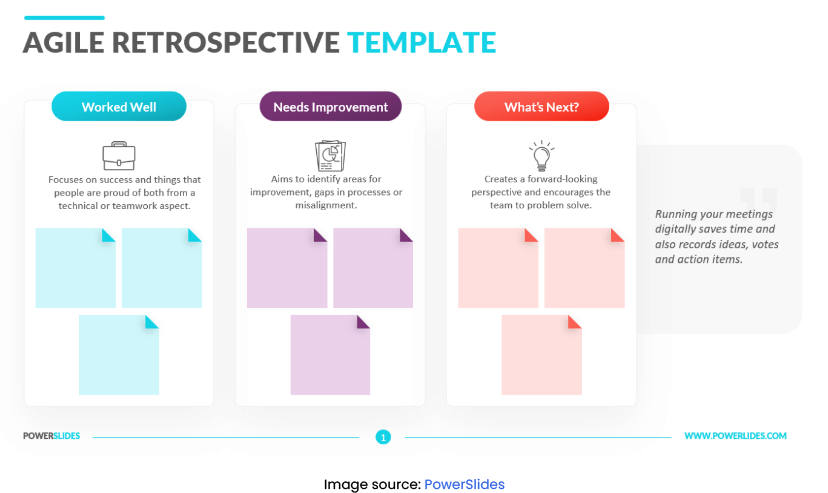
If you’ve ever watched Formula 1 racing, you know about the pit stop.
In a race, a pit stop is a strategic pause during which the race car is brought into the pit lane for refueling, tire changes or repairs. Similarly, the retrospective serves as a designated pause in the Agile project, allowing the team to analyze their performance, make necessary adjustments, and prepare for the next “race” (i.e. iteration or sprint).
Four basic questions to ask in an Agile retrospective
To better understand what an Agile retrospective is, it’s useful to know the questions that are typically asked during these meetings. These questions help guide the retrospective discussion and reveal the methodology in Agile retrospectives.
- What went well? – This question encourages the team to identify and discuss the positive aspects of their work. It focuses on recognizing successes, achievements, and effective practices.
- What didn’t go well? – This prompts the team to discuss the challenges, issues, or shortcomings encountered during the project. Plus, it points to areas for improvement and potential obstacles to address.
- What have we learned? – Next, the team reflects on the lessons learned. They’re encouraged to identify insights, best practices, and knowledge that can be useful in future work.
- What will we do differently next time? – Finally, the team focuses on generating actionable improvements for the next iteration. They brainstorm and plan specific changes to enhance their Agile process and outcomes.
These four questions provide a framework for a comprehensive Agile retrospective discussion, covering both the positive and negative aspects and driving successful transformation in Agile teams.
Discovering retrospective ideas for new Agile teams
Luckily, there is no shortage of ways to keep retrospectives engaging, insightful, and impactful. You have countless retrospective ideas to choose from, offering a wide array of options to spark innovation and enhance performance.
Here are tested retrospective ideas for agile teams:
Start, Stop, Continue
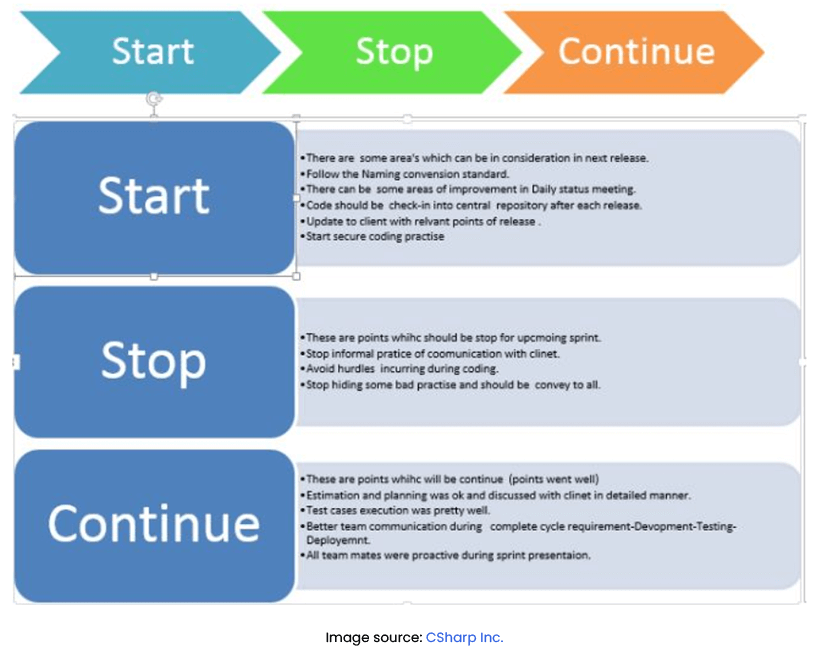
This technique is about having team members reflect on what they should start doing, stop doing, and continue doing in the next project. As a result, they can identify specific actions and behaviors that can drive improvement.
Mad, Sad, Glad
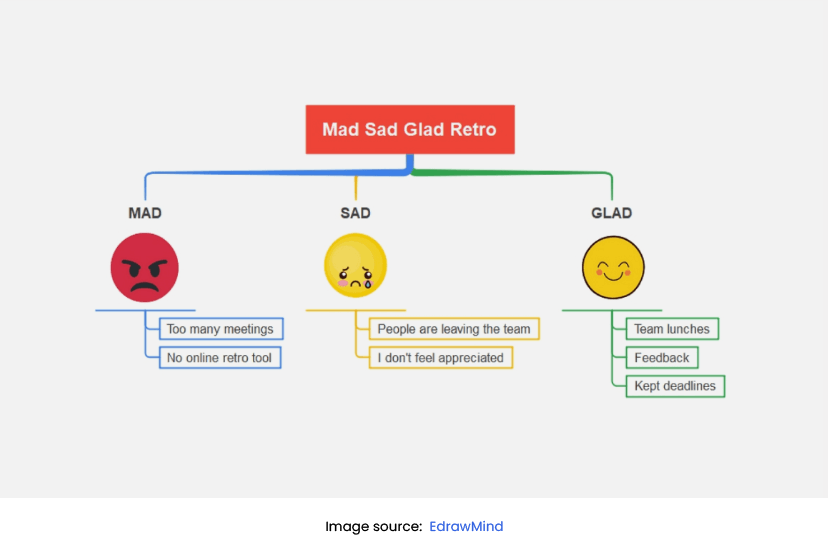
Reveal the hidden sides of your team’s experiences by inviting them to discuss the moments that ignited their anger, stirred their sadness, and sparked their joy throughout the project. This retrospective format encourages individuals to express their emotions and provides valuable insights into team dynamics and satisfaction.
Sailboat or Speedboat
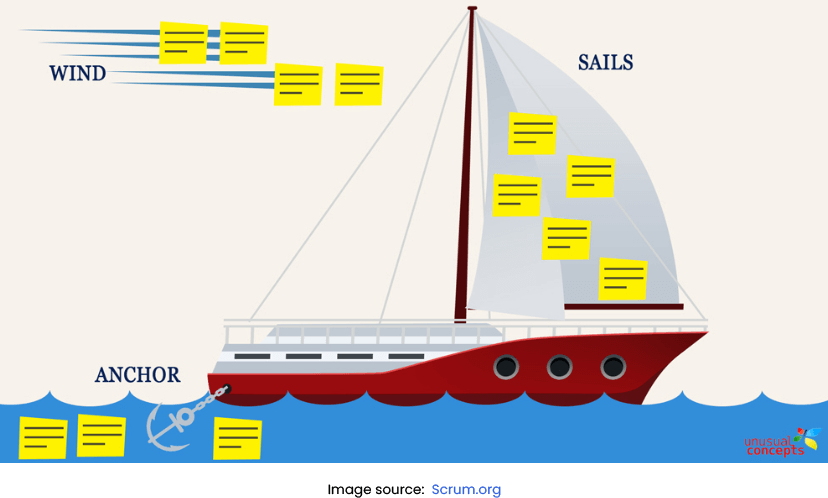
When running a retrospective in an Agile setting, use a sailboat or speedboat visual metaphor to represent the team’s journey. Ask team members to identify the wind (positive factors that propel the team forward) and the anchors (negative factors that hold the team back). Discuss how to maximize the wind and address the anchors.
Five Whys
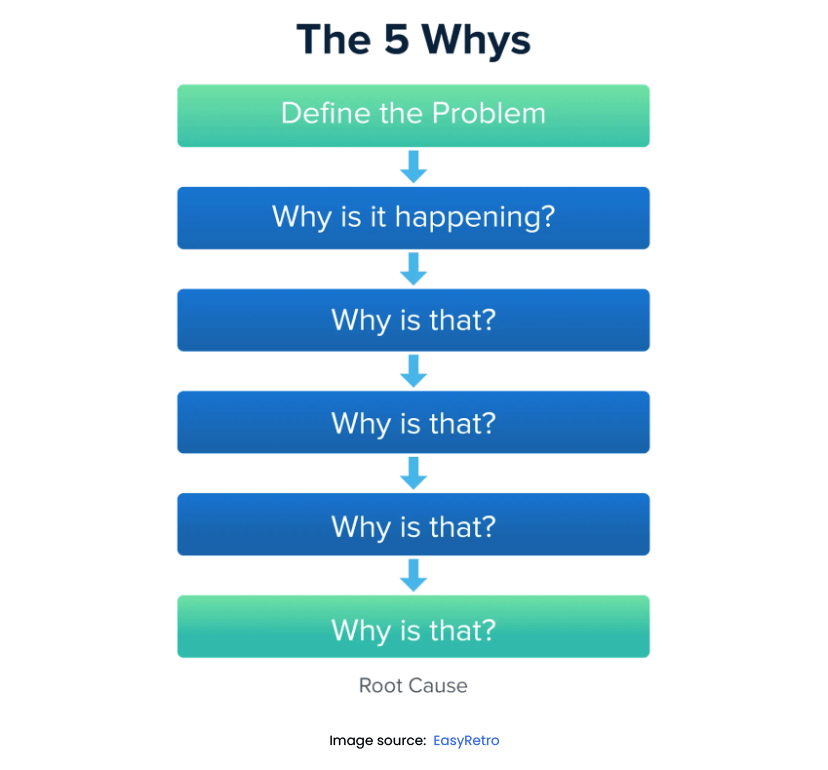
To run a successful Agile retrospective, utilize the 5 Whys technique to dig deeper into the root causes of issues or challenges. In fact, asking “why” at least five times can work wonders. It can help the team uncover underlying factors and brainstorm effective solutions.
Lean Coffee
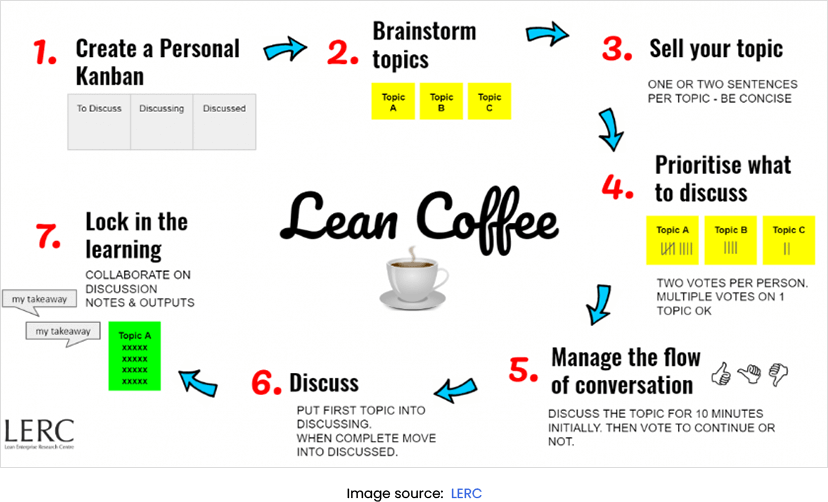
It’s coffee time! Adopt the Lean Coffee format, where team members suggest discussion topics, vote on them, and allocate time for focused discussions on the most popular topics. This approach allows for dynamic and participant-driven Agile retrospectives.
4 L’s Retrospective
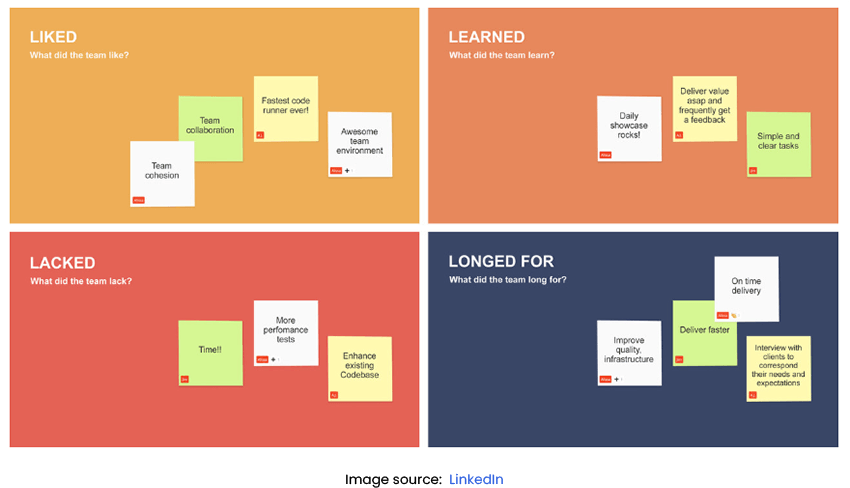
Divide a whiteboard or flipchart into four quadrants: Liked, Learned, Lacked, and Longed For. Team members contribute sticky notes to each category, sharing what they liked about the sprint, what they learned, what’s lacking, and what they long for in future sprints. This technique helps identify areas for improvement and future goals.
Your sample agenda: An example of Agile retrospective
In Agile retrospectives, there are typically six stages that guide the process – welcoming, celebrating achievements, reflecting on issues, determining improvements, crafting an action plan, and closing.
Here’s an example of an agenda for Agile retrospectives that clearly indicates these stages:
Agile Retrospective: Celebrate, Reflect, Improve.
Objective: To celebrate successes, reflect on challenges, and identify improvements for our next UX/UI project.
Duration: 60 minutes
Agenda:
1. Welcome and Warm-up (5 minutes)
- Start the retrospective by welcoming the team and setting a positive tone.
- Conduct a quick warm-up activity to energize the team, such as a short icebreaker question or a fun team-building exercise.
2. Celebrate Successes (10 minutes)
- Invite team members to share individual or team successes achieved during the project.
- Encourage open and positive discussions, allowing everyone to express their achievements and acknowledge each other’s contributions.
3. Reflect on Challenges (20 minutes)
- Discuss the challenges and obstacles encountered during the project.
- Use a visual aid like a whiteboard or sticky notes to capture the challenges raised by the team.
- Facilitate a constructive conversation to understand the root causes and impact of these challenges.
4. Identify Improvements (20 minutes)
- Brainstorm as a team to generate ideas for improvements.
- Use a retrospective format like Start, Stop, Continue or Mad, Sad, Glad to guide the discussion (see the previous section for more inspiration).
- Prioritize the improvement ideas and focus on those that’ll have the most significant impact on our work.
5. Action Planning (5 minutes)
- Determine specific, actionable items to address the identified improvements.
- Assign responsible team members for each task and set realistic deadlines.
- Ensure that the action items are clear, measurable, and achievable.
6. Closing and Motivation (5 minutes)
- Summarize the key takeaways from the retrospective discussion.
- Appreciate the team’s participation, insights, and commitment to improvement.
- Share an inspiring quote or story that motivates the team and reinforces the value of Agile retrospectives.

Agile retrospective tools to enhance your workflow
In the digital age, one thing is certain: without the proper tools, efficiency remains out of reach.
Now, let’s explore the five best tools to help you with organizing and completing a retrospective meeting in Agile. These tools provide features and functionalities that can facilitate collaboration, documentation, and analysis during the retrospective process.
1. Trello
With Trello, teams can create boards, lists, and cards to capture retrospective action items, discuss ideas, and track progress.
2. Miro
Miro is an online whiteboarding platform that enables teams to collaborate in real time. It offers a range of sticky note and visual collaboration tools to capture and organize retrospective insights and tasks.
3. TeamRetro
TeamRetro is a feature-rich tool designed for Agile retrospectives. It offers a variety of retrospective templates, collaborative boards, voting capabilities, and action item tracking. Also, it integrates with popular Agile project management tools like Jira and Azure DevO ps.
4. Google Jamboard
Google Jamboard provides a digital canvas that allows teams to brainstorm, capture ideas, and collaborate visually during retrospectives. You have a whiteboard for drawing, writing, and adding sticky notes.
5. Teamly
When it’s time for retrospective action planning, Teamly is the best tool (especially when the team is remote). Teamly provides robust functionalities for visual communication, screen recording, real-time chat and more. You can easily add and assign tasks, insert details about the assignment, and visually track the progress. Once the task is complete, click “Archive” and… Wait for new tasks from your next Agile retrospective meeting!
Final thoughts
In conclusion, the Agile retrospective meeting serves as a dedicated space for teams to collectively shape their future success. Use this space to reflect on your past experiences, celebrate achievements, address challenges, and craft action plans for improvement.
By leveraging retrospective tools and conducting Agile retrospective meetings regularly, you can continuously learn, adapt, and evolve with each project.
Don’t forget to incorporate retrospective ideas into your Agile workflows. They’ll foster a culture of continuous improvement and drive success!
















